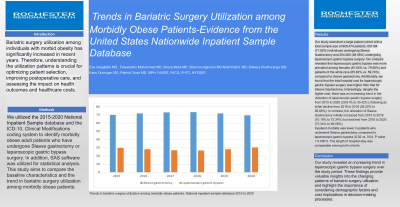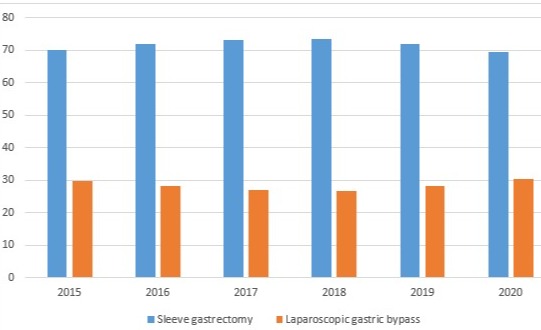Tuesday Poster Session
Category: Obesity
P4031 - Trends in Bariatric Surgery Utilization Among Morbidly Obese Patients - Evidence from the United States Nationwide Inpatient Sample Database
Tuesday, October 24, 2023
10:30 AM - 4:00 PM PT
Location: Exhibit Hall

Has Audio

Ese Uwagbale, MD
Rochester General Hospital
Rochester, NY
Presenting Author(s)
Ese Uwagbale, MD1, Faisaluddin Mohammed, MD1, Sheza Malik, MD1, Solomon Agbroko, MD2, Nida Khalid, MD1, Dileepa Chathuranga, MD1, Karin Dunnigan, MD1, Patrick Okolo, MD, MPH, FACG1
1Rochester General Hospital, Rochester, NY; 2Maimonides Medical Center, Brooklyn, NY
Introduction: Bariatric surgery utilization among individuals with morbid obesity has significantly increased in recent years. Therefore, understanding the utilization patterns is crucial for optimizing patient selection, improving postoperative care, and assessing the impact on health outcomes and healthcare costs.
Methods: We utilized the 2015-2020 National Inpatient Sample database and the ICD-10, Clinical Modifications coding system to identify morbidly obese adult patients who have undergone Sleeve gastrectomy or laparoscopic gastric bypass surgery. In addition, SAS software was utilized for statistical analysis. This study aims to compare the baseline characteristics and the trend in bariatric surgery utilization among morbidly obese patients.
Results: Our study examined a large patient cohort with a total sample size of 905,474 patients. 651194 (71.92%) individuals undergoing Sleeve Gastrectomy and 254,280 (28.08%) undergoing laparoscopic gastric bypass surgery. Our analysis revealed that laparoscopic gastric bypass was more prevalent among females (81.64% vs. 79.56%) and patients of the white race (65.82% vs. 59.74%) compared to sleeve gastrectomy. Additionally, we found that the total hospital cost for laparoscopic gastric bypass surgery was higher than that for Sleeve Gastrectomy. Interestingly, despite the higher cost, there was an increasing trend in the utilization of laparoscopic gastric bypass surgery from 2015 to 2020 (29.81% to 30.42%), following an initial decline from 2016 to 2018 (28.22% to 26.66%). In contrast, the utilization of Sleeve Gastrectomy initially increased from 2015 to 2018 (70.19% to 73.34%) but declined from 2018 to 2020 (73.34% to 69.58%).
Inpatient mortality was lower in patients who underwent Sleeve gastrectomy compared to laparoscopic gastric bypass (0.02 vs. 0.04, P value < 0.0001). The length of hospital stay was comparable among both cohorts.
Discussion: Our study revealed an increasing trend in laparoscopic gastric bypass surgery over the study period. These findings provide valuable insights into the changing patterns of bariatric surgery utilization and highlight the importance of considering demographic factors and cost implications in decision-making processes.

Disclosures:
Ese Uwagbale, MD1, Faisaluddin Mohammed, MD1, Sheza Malik, MD1, Solomon Agbroko, MD2, Nida Khalid, MD1, Dileepa Chathuranga, MD1, Karin Dunnigan, MD1, Patrick Okolo, MD, MPH, FACG1. P4031 - Trends in Bariatric Surgery Utilization Among Morbidly Obese Patients - Evidence from the United States Nationwide Inpatient Sample Database, ACG 2023 Annual Scientific Meeting Abstracts. Vancouver, BC, Canada: American College of Gastroenterology.
1Rochester General Hospital, Rochester, NY; 2Maimonides Medical Center, Brooklyn, NY
Introduction: Bariatric surgery utilization among individuals with morbid obesity has significantly increased in recent years. Therefore, understanding the utilization patterns is crucial for optimizing patient selection, improving postoperative care, and assessing the impact on health outcomes and healthcare costs.
Methods: We utilized the 2015-2020 National Inpatient Sample database and the ICD-10, Clinical Modifications coding system to identify morbidly obese adult patients who have undergone Sleeve gastrectomy or laparoscopic gastric bypass surgery. In addition, SAS software was utilized for statistical analysis. This study aims to compare the baseline characteristics and the trend in bariatric surgery utilization among morbidly obese patients.
Results: Our study examined a large patient cohort with a total sample size of 905,474 patients. 651194 (71.92%) individuals undergoing Sleeve Gastrectomy and 254,280 (28.08%) undergoing laparoscopic gastric bypass surgery. Our analysis revealed that laparoscopic gastric bypass was more prevalent among females (81.64% vs. 79.56%) and patients of the white race (65.82% vs. 59.74%) compared to sleeve gastrectomy. Additionally, we found that the total hospital cost for laparoscopic gastric bypass surgery was higher than that for Sleeve Gastrectomy. Interestingly, despite the higher cost, there was an increasing trend in the utilization of laparoscopic gastric bypass surgery from 2015 to 2020 (29.81% to 30.42%), following an initial decline from 2016 to 2018 (28.22% to 26.66%). In contrast, the utilization of Sleeve Gastrectomy initially increased from 2015 to 2018 (70.19% to 73.34%) but declined from 2018 to 2020 (73.34% to 69.58%).
Inpatient mortality was lower in patients who underwent Sleeve gastrectomy compared to laparoscopic gastric bypass (0.02 vs. 0.04, P value < 0.0001). The length of hospital stay was comparable among both cohorts.
Discussion: Our study revealed an increasing trend in laparoscopic gastric bypass surgery over the study period. These findings provide valuable insights into the changing patterns of bariatric surgery utilization and highlight the importance of considering demographic factors and cost implications in decision-making processes.

Figure: Trends in bariatric surgery utilization among morbidly obese patients. National inpatient sample database 2015 to 2020
Disclosures:
Ese Uwagbale indicated no relevant financial relationships.
Faisaluddin Mohammed indicated no relevant financial relationships.
Sheza Malik indicated no relevant financial relationships.
Solomon Agbroko indicated no relevant financial relationships.
Nida Khalid indicated no relevant financial relationships.
Dileepa Chathuranga indicated no relevant financial relationships.
Karin Dunnigan indicated no relevant financial relationships.
Patrick Okolo indicated no relevant financial relationships.
Ese Uwagbale, MD1, Faisaluddin Mohammed, MD1, Sheza Malik, MD1, Solomon Agbroko, MD2, Nida Khalid, MD1, Dileepa Chathuranga, MD1, Karin Dunnigan, MD1, Patrick Okolo, MD, MPH, FACG1. P4031 - Trends in Bariatric Surgery Utilization Among Morbidly Obese Patients - Evidence from the United States Nationwide Inpatient Sample Database, ACG 2023 Annual Scientific Meeting Abstracts. Vancouver, BC, Canada: American College of Gastroenterology.
